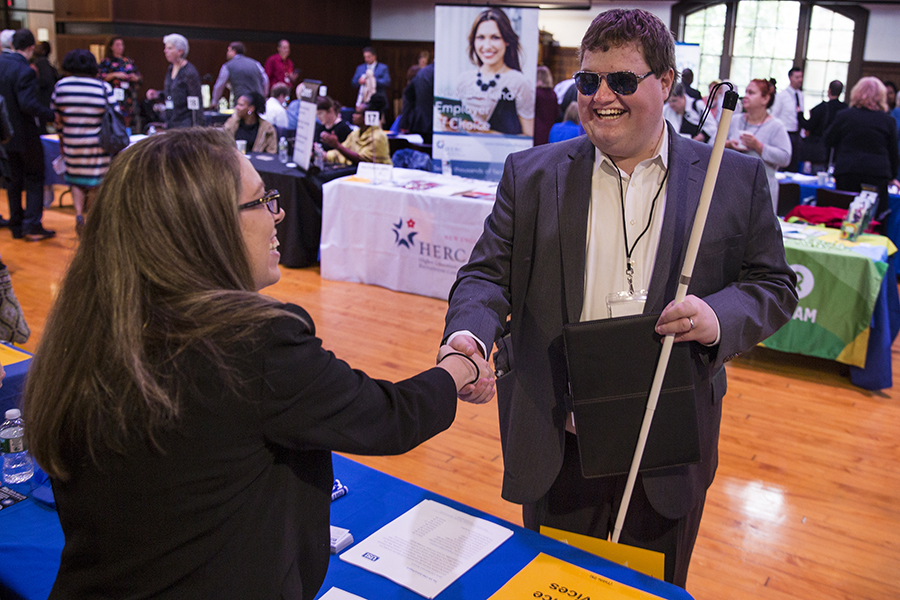Job Fair for Visually Impaired Highlights Homogeneity of Options in Boston Job Market

Mark Cadigan speaks with Rebecca Libitz, who is with USI Insurace Services, during the Job Fair for Individuals with Visual Impairment at Radcliffe on Wednesday October 25, 2017.
After the handshake comes the elevator pitch. If that goes well, it’s on to the informational chit chat and the business card exchange. The job fair’s manic waltz is a carefully choreographed, high-stakes romp. And when the dance lights start to shine, sometimes all you can hope is that your cold, clammy hands don’t smudge the ink on your freshly printed résumé.
Job fairs can bring to bear all sorts of jitters, expectations, and concerns, and the scene at Harvard’s Radcliffe Institute for Advanced Study in late October was no different. But in addition to leather folios and crisp button-down shirts, the applicants also arrived with their white canes and guide dogs. Radcliffe hosted the seventh annual job fair for individuals with visual impairments, bringing together 60 registered job seekers and roughly 30 companies ready to employ them.
The fair—which was put on in conjunction with the Perkins School for the Blind, the Massachusetts Commission for the Blind, the Carroll Center for the Blind, and the National Braille Press—is a concerted effort to improve the visually impaired employment rate. That rate stood at a staggeringly low 42 percent in 2015, as compared to a nationwide employment rate of 78 percent for working-age adults.
But along with nerves and excitement, another fact hung over the fair: how many similarities the companies equipped to hire visually impaired candidates in the gymnasium shared.
From Cambridge Health Alliance and Harvard Medical School to Mass Ear and Eye and Tufts Medical Plan, a hefty chunk of the recruiters were from health-related fields, in addition to social justice organizations and government offices.
But anyone expecting a presence from Boston’s thriving biotech scene or its much touted startup culture would walk away disappointed. Despite the sectors’ reputations for modernity, they’re not particularly cutting edge when it comes to addressing this type of diversity. And the lack of representation at the job fair sends a message to potential applicants.
Moreover, organizers say their outreach efforts to get other industries to attend have not met with success. Charles Curti, Radcliffe’s director of human resources, said he’s called up to 40 employers in a single day to talk about setting up tables at the fair. He estimated roughly 85 percent of companies across industries offered nothing but radio silence.
“They treated me like a job seeker they didn’t want to talk to: We’ll get back to you, we’ll look at it for next year, we’ll see about following up,” Curti said, “Sometimes it’s like speaking into the wind.”
All of the people attending the job fair are pre-screened, and their résumés are vetted by fair organizers to make sure they have marketable skills. The event is also free to employers, in contrast to fairs at places like MIT and Northeastern, where a table can cost hundreds of dollars. That the event sponsors do this leg work and require no monetary investment up front further vexed Curti, who said he was disheartened by the general lack of interest.
In particular, the lack of technology companies in a city firmly entrenched in startup culture was apparent: Just 1 of the 29 employers at the fair were from the technology sector. In a statement following the job fair, Curti said that the technology sector is filled with “ideal employers for people with visual impairments,” not only because they frequently have job openings, but also because the very nature of their work should make them more amenable to adaptive technologies.
Dina Rosenbaum, the chief program officer for the Carroll Center, said the organizers aim for variety when creating the fair’s lineup. She emphasized that “blindness doesn’t discriminate,” and finding opportunities for candidates with all education levels is key. Employers are often concerned about the expense of accommodating a blind person, Rosenbaum said, but thanks to technology, a vast spectrum of jobs can be accomplished by a visually impaired employee.
Boston still has a long way to go to make the city accessible. According to the American Federation for the Blind (AFB), 127,514 visually impaired people lived in Massachusetts in 2015, which is around the median total for states nationwide. And yet, despite not having an outsized population here already, Rosenbaum said the state is an attractive destination for blind people.
“I think a lot of people move to Massachusetts or move to the greater Boston area for a job opportunity,” Rosenbaum said.“Massachusetts is more progressive, it’s a more supportive state for social services for the blind, so we have people in other states who move to Massachusetts so they can get more services and more opportunity.”
Paul Saner, the commissioner of the Massachusetts Commission for the Blind, said technology companies have attended the fair in the past, though accessibility in the state is still a “work in progress.”
He said one key component in closing the employment gap is simply helping companies understand what adaptability improvements are required for a visually impaired worker. Employers nervous about what’s involved might be surprised by how cheap it is to take steps to make technology accessible; in fact, the AFB notes some screen readers are free. On top of that, the group lists out some pretty easy accessibility instructions on its site, and there are visual accessibility settings already baked into Microsoft Office.
Original story by HAYLEY GLATTER
Read more at article source: http://www.bostonmagazine.com/news/2017/11/07/blind-employment-boston-diversity/


